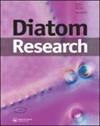The conspecificity of Aulacoseira konstantinovii and Praecyclostephanos boengchhmariensis with comments on the genus Praecyclostephanos
IF 1.3
3区 生物学
Q2 MARINE & FRESHWATER BIOLOGY
引用次数: 0
Abstract
AbstractThe centric diatom species Aulacoseira konstantinovii was described from Lake Tonlé Sap (Cambodia) but was erroneously assigned to the genus Aulacoseira. Subsequently, based on a unique set of morphological characters, the genus Praecyclostephanos with the single species P. boengchmariensis was established based on the material from this lake. Examination of published data has allowed us to compare the morphology of A. konstantinovii and P. boengchmariensis and confirm their conspecificity. A new combination, Praecyclostephanos konstantinovii comb. nov., is therefore proposed.Keywords: AulacoseiraPraecyclostephanoscentric diatomsmorphologysystematicstaxonomySoutheast Asia AcknowledgementsThe work of S.I. Genkal was carried out within the institutional research project ‘Diversity, Structure and Functioning of Algal and Plant Communities in Continental Waters’ (No. 121051100099-5) of the Papanin Institute for Biology of Inland Waters RAS. The work of A.M. Glushchenko was carried out within the state assignment of Ministry of Science and Higher Education of the Russian Federation (theme No. 122042700045-3). The work of M.A. Gololobova was carried out as part of the Scientific Project of the State Order of the Government of Russian Federation to Lomonosov Moscow State University (No. 121032300080-0). We are very grateful to two anonymous reviewers for constructive and helpful comments, to Loïc Tudesque for permission to use micrographs of Praecyclostephanos boengchmariensis, and Nicholas Turland for his explanations concerning nomenclature and the Code. We are also very grateful to Eileen J. Cox for editing and linguistic corrections to the manuscript.Disclosure statementNo potential conflict of interest was reported by the author(s).Additional informationFundingThis work was supported by Ministry of Science and Higher Education of the Russian Federation: [Theme Number 122042700045-3]; Scientific Project of Lomonosov Moscow State University: [Theme Number 121032300080-0]; Papanin Institute for Biology of Inland Waters RAS.: [Theme Number No. 121051100099-5].孔雀鱼与波氏原环stephanos boengchmariensis的同质性及对原环stephanos属的评析
摘要本研究发现的中心硅藻种Aulacoseira konstantinovii来自柬埔寨的tonl湖(Lake tonl Sap),但被错误地归入Aulacoseira属。随后,基于一组独特的形态特征,以该湖泊的材料为基础,建立了Praecyclostephanos属和P. boengchmariensis单种。检查已发表的资料,使我们能够比较A. konstantinovii和P. boengchmariensis的形态,并确认它们的同一性。一种新组合,常青藤梳。因此建议11月11日。S.I. Genkal的工作是在内陆水域生物研究所的机构研究项目“大陆水域藻类和植物群落的多样性、结构和功能”(No. 121051100099-5)中进行的。A.M.的作品。Glushchenko是在俄罗斯联邦科学和高等教育部的国家任务范围内进行的(主题号122042700045-3)。ma Gololobova的工作是作为俄罗斯联邦政府对罗蒙诺索夫莫斯科国立大学的国家命令科学项目(编号121032300080-0)的一部分进行的。我们非常感谢两位匿名审稿人的建设性和有益的意见,Loïc Tudesque允许我们使用Praecyclostephanos boengchmariensis的显微照片,以及Nicholas Turland对命名法和代码的解释。我们也非常感谢Eileen J. Cox对手稿的编辑和语言修改。披露声明作者未报告潜在的利益冲突。本工作得到俄罗斯联邦科学和高等教育部的支持:[主题号122042700045-3];莫斯科国立罗蒙诺索夫大学科学项目[主题号121032300080-0];内陆水域生物研究所。:[主题号121051100099-5]。
本文章由计算机程序翻译,如有差异,请以英文原文为准。
求助全文
约1分钟内获得全文
求助全文
来源期刊

Diatom Research
生物-海洋与淡水生物学
CiteScore
2.70
自引率
16.70%
发文量
27
审稿时长
>12 weeks
期刊介绍:
Diatom Research is the journal of the International Society for Diatom Research. The journal is published quarterly, in March, June, September and December, and welcomes manuscripts on any aspect of diatom biology.
In addition to full-length papers, short notes and reviews of recent literature are published which need not contain all the sections required for full-length papers; we see these as being necessary to record information which is of interest but which cannot be followed up in detail. Discursive “Opinion” papers are encouraged which would not necessarily follow the normal lay-out. If extremely long papers are to be offered, the author(s) should contact the editors first to discuss any problems. Book reviews, obituaries and meeting reports can be published. All papers will be subject to critical review by the editors and referees, as appropriate to their content. Papers will be accepted in English only.
 求助内容:
求助内容: 应助结果提醒方式:
应助结果提醒方式:


